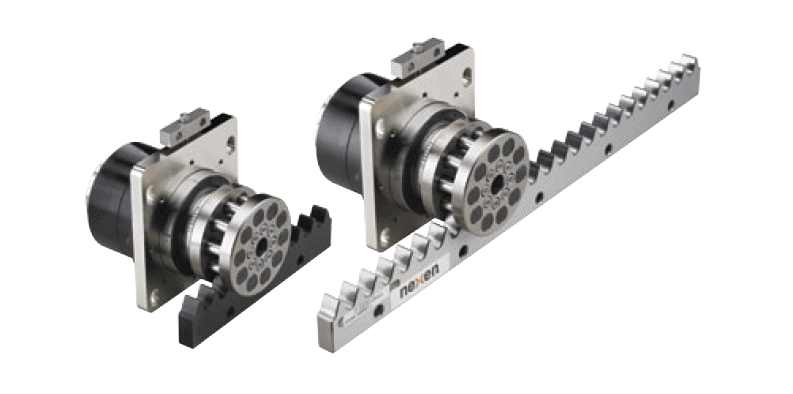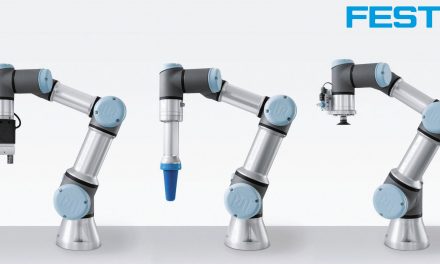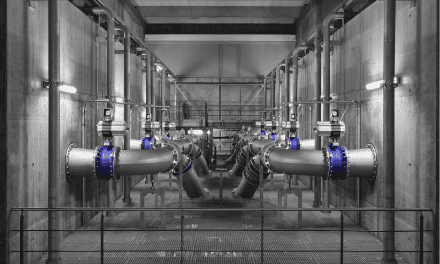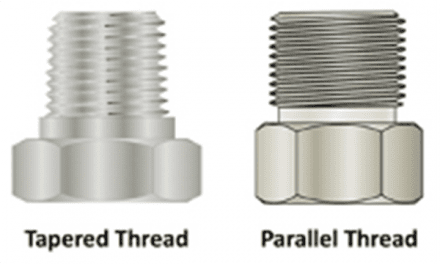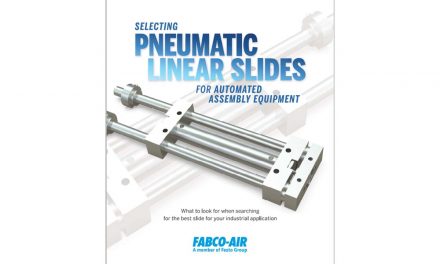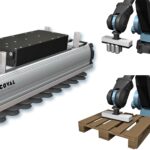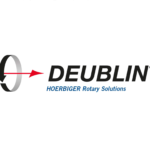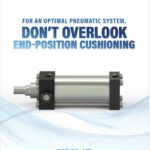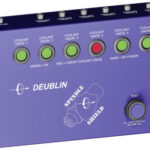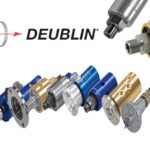The following is from Nexen Group, a partner of Direct Pneumatics
Introduction
Competitive market pressures are pushing machine builders to design machines that are faster, more precise, and require less maintenance so they are more productive for their end users. In pursuit of these goals, more servo controlled linear drive systems are being employed.
Linear drives are based several common technologies like ball screws, rack and pinion, belt drives, and linear motors. Each of these technologies have their strengths and weaknesses making none of them ideal for all applications due to shortcomings like backlash, low rigidity, cumulative error, thermal creep, limited length, low speeds, low force capability, vibration, noise, particle emissions, high maintenance, low life, and high cost(1).

To address these linear drive systems limitations Nexen introduced the Roller Pinion System, a new, patented linear drive concept that combines the best attributes of the existing technologies while eliminating most of their shortcomings.
(1) Berardinis, Larry. “Rotary to Linear Converters”. Motion Systems Design. May 2002: 28-33.
(1) Hyatt, Greg. “Ball Screws or Linear Motors? Apps, Not Specs Determine Which is Best”. Moldmaker. April 2002.
www.moldmakermag.com/0402tech1.html.
(1) Hoagland, Jonathan. “Avoiding the ‘Vertical Load Mistake’”. 17, December 2001. www.motioncontrol.com.
How It Works:
The Nexen Roller Pinion System (RPS) takes the traditional rack and pinion concept and advances it by replacing spur gear teeth with bearing supported rollers that engage a unique rack tooth profile. The bearing supported rollers eliminate the sliding friction of traditional rack and pinion with smooth rolling friction that give a 99% efficient rotary to linear motion conversion.

The above illustrations show rack tooth profile development.
In figure 1, the initial cord is drawn as the circle rolls forward and point P rotates to point Pl.
Figure 2, shows several evenly spaced points going through the same process and developing basic tooth profiles.
In figure 3, the point is replaced with a roller modifying the tooth profile.
In figure 4, a further modification of the tooth profile causes the rollers to be loaded in opposition eliminating the backlash. With this meshing geometry, the roller glides into the tooth face following a tangent path resulting in no tooth slap that generates noise, vibration or tooth fatigue – unlike traditional rack and pinion.
System Diversity
Fortified by a keen understanding of the diverse motion control needs facing many of today’s industries and applications, the Roller Pinion System was expanded to include five specially engineered models designed to meet unique and challenging motion control demands. Available models include the Standard, Premium, Endurance, Universal and Stainless Steel Universal Rack, each providing distinct performance capabilities that make them ideal for specific industries and/ or applications. For further suitability, each model can be sized to meet exact machine specifications. The addition of these models increases machine designers’ ability to incorporate the roller pinion technology into their applications.
With the expansion of the RPS, models are available with corrosion resistant surface treatments and/or made from 17-4 stainless steel for difficult applications. Pinions are available in shaft mount with a keyless mechanical compression bushing or ISO 9409 flange mount versions for optimal machine design flexibility. The RPS ISO 9409 flange mount pinions make reducer selection and mounting easier, allows the use of pinion preloaders, and gives maximum system performance.
By selecting a rack that compliments exact application and machine requirements, the RPS can provide users with production advantages in demanding markets. For example, the Standard Rack is heat treated, features 50 micron accuracy and offers the highest load carrying capacity. This makes it the ideal motion control solution for injection molding machines and laminating machines. In harsh environmental conditions, the Premium Rack delivers superior corrosion protection with lubrication-free operation, which makes it a reliable solution in demanding applications such as honing machines, aircraft assembly, five axis ceramic and carbon fiber profiling machines.
For intricate applications requiring pinpoint accuracy, the Endurance Rack was developed for counting, sorting and bagging machines, delivering the precision and durability necessary to ensure consistent product quality. Alternatively, in applications with strict sanitation regulation, the Stainless Steel Universal Rack was developed with extreme corrosion resistance for food grade applications, such as packaging and filling machines. Providing an economical, high-quality motion control solution, the Universal Rack features medium hardness and ensures the precision necessary for glass and pipe cutting applications.
Positional Accuracy
The RPS rack uses a modular concept with only two standard factory lengths per size that are joined to create runs of any length. Full lengths are around one meter in length and half-lengths around . meter in length depending on tooth pitch. Shorter rack segments can be made by cutting the rack.
Featuring positional accuracy up to 30, 50 and 80 microns, the RPS accommodates virtually any application’s precision requirement. Further, by offering diverse performance capabilities, engineers can optimize their performance/price ratio for a specific machine design. Typically, the Premium rack offers accuracy of 30 microns, while Standard, Universal and Stainless Steel Universal racks will feature positional accuracy of 50 microns and the Endurance rack is capable of positioning precision up to 80 microns.
To transfer the positional accuracy to the following rack segments, a special tool was developed that uses the rack tooth profile to set the rack spacing rather than simply butting racks end to end. The alignment tool uses two teeth on each rack averaging out some of the transferred error. This small transferred error is Å} each time and statistically trends to zero, so an infinitely long run would, in theory, have zero cumulative error. This allows runs of virtually any length without loss of system accuracy. In many cases, a linear encoder is no longer needed and the servo encoder can be relied on reducing cost and complexity.

This graph shows the positional accuracy based on very precise linear encoder and rotary encoder on the pinion shaft.
Looking at the wave pattern you will see individual spikes representative of individual pin and rack meshing error and a general periodic wave pattern representing the error in the pinion body that repeats with each revolution. As you can see, the error bar lines are horizontal showing no cumulative error. This would continue throughout any individual rack segment or run length.

This graph illustrates repeated returns to the same locations from one direction and both directions. As you can see repeatability from one direction is better than 2.6 μm and from both directions better than 5.8 μm. The difference between these two numbers is the backlash in the system and is less than 3.2 μm. This will hold true over virtually any length run.
Speed
The RPS system is capable of speeds up to 11 meters (36.1 ft) per second making it the fastest mechanical linear drive system second only to linear motors. Even at these speeds, the extremely-low friction design creates minimal heat and wear on components. Each individual RPS system has a maximum speed limitation that is a function of the specific needle bearings used in the roller pinion. In practice, the roller pinion is designed to perform at faster rates than the other components in the system, such as linear bearings and utility carrier—delivering more speed capacity than required by the machine.
Durability
The rack and pinion body is made from carbon steel. The rack teeth are heat treated to make an exceptionally wear resistant, long lasting product. In many applications, liquids and corrosive materials would pose a problem for an unprotected steel product. Stainless steel is not a viable option since it has less strength, and would compromise RPS performance. Due to extremely tight manufacturing tolerances the RPS requires a coating that does not build up on the surface, or could quickly wear away. As a result, the RPS uses a protective surface treatment called Raydent. The Raydent surface treatment is a cryogenic process that permeates the metal surface and molecularly bonds with the steel forming a ceramic chrome layer while causing minimal surface buildup. It is extremely durable and highly resistant to acids, alkalis, and various solvents. It will not flake or rust if scratched. If a thin piece of metal is treated with Raydent and then sharply bent in half the coating will not be compromised.
Noise
Due to the smooth way the rollers engage the rack teeth the RPS system generates very low noise and vibration. It does not suffer from the noise caused by tooth slap or recirculating balls that other linear drive systems have. Eliminating sliding friction allows the RPS to operate substantially quieter than standard rack and pinion, and their rolling friction operating principle efficiency.
The system is whisper quiet at low speeds and less than 75 db at full speed. Typically, the guiding system, servomotor, and reducer generate more noise than the RPS system. Less noise and vibration is always desirable since it reduces inaccuracy in precision sensors and encoders and creates a better working environment for personnel who may have to work near the machinery.

Maintenance
The RPS system is low maintenance while providing a very long life. The pinion consists of 10 or 12 needle-bearing, supported rollers that are sealed and lubricated for life and is therefore maintenance free. The rack is lubricated with a high performance light grease at installation and then every six months or 2 million pinion revolutions. In special applications the RPS system can be run lubrication free as long as the speed is less than 30 m/min. Other mechanical linear drive systems require more frequent lubrication or maintenance. Only a linear motor requires less.
Each RPS model is constructed to minimize maintenance requirements, with each pinion lubricated on the factory floor and requiring no in-service maintenance. Plus, depending on operational speeds, the Premium and Endurance racks do not require lubrication if performing at .5 m/s or under, and only small amounts of lubrication are necessary for Standard and Universal Racks.
Since the lubrication requirements are very low or nonexistent, the RPS system has very low particle emissions making it ideal for applications such as clean rooms, food processing, coating operations and pharmaceutical production. Even with very low maintenance the RPS system provides 60,000,000 pinion revolutions of life at its rated performance. That’s 9.6 – 28.8 million meters (3.2 – 95.5 million feet) when properly installed and maintained! The RPS system continues to operate beyond this point with diminishing accuracy.
No lubrication can also be very beneficial in dirty applications such as cutting, milling and routing. Contaminants are less likely to stick to the rack, reducing the creation of an abrasive paste that accelerates wear in mechanical systems.
Many linear drive technologies are sized by starting with a life consideration with the product size increasing with the life requirements. The RPS system selection process does not take life into consideration and is primarily based on load. No other mechanical linear drive system comes close to this performance and is only exceeded by a linear motor.
Installation
Installing the RPS system is comparable to the installation of precision profile guide rails. The rack should be placed on a step in the machine bed to provide full bottom support and a backplane for bolting it in place and to ensure straightness especially when joining rack sections.
Once the pinion is mounted, and its axis is properly positioned parallel to the rack tooth faces and fully engaged in the rack, a small preload is applied to take up the clearance in the pinion roller bearings. A high degree of rack mounting surface flatness is desirable, but more important is the parallelism between the guiding system and the RPS so pinion preload is neither lost nor becomes excessive. Since each rack features the same simplistic installation process, the RPS is universally designed to minimize downtime and lost production.
Summary
Nexen’s Roller Pinion System offers a new linear drive solution that combines the best features of traditional linear drive systems like ball screws, rack and pinion, belt drives and linear motors while eliminating many of their shortcomings. With five separate and distinct models, the RPS delivers a specially-engineered motion control solution that consistently ensures high positional accuracy, speed, rigidity and longevity.
Authors
Allan Conway, Nexen Group, Inc.
Jeff Hermes, Nexen Group, Inc.
About Nexen
Nexen is a leading manufacturer of brakes, clutches, linear motion control devices, torque limiters, and web tension control systems for a variety of industrial applications ranging from motion control and robotics to packaging and material handling. With headquarters in Vadnais Heights, Minn., Nexen has sales offices and distributor sales outlets throughout the world.

